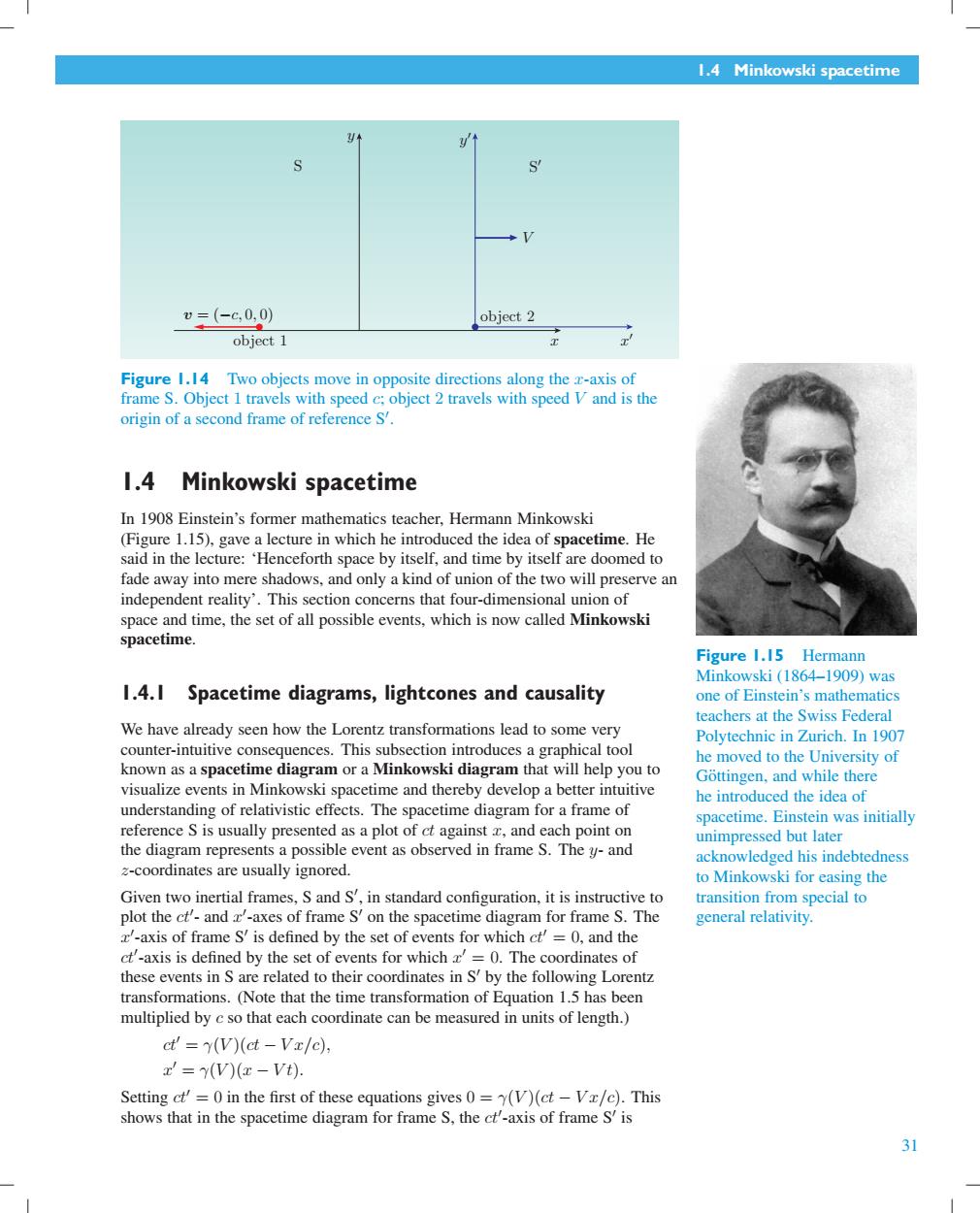正在加载图片...

1.4 Minkowski spacetime S S v=(-c00) object 2 object 1 2 Figure 1.14 Two objects move in opposite directions along the z-axis of frame S.Object 1 travels with speed c:object 2 travels with speed V and is the origin of a second frame of reference S'. 1.4 Minkowski spacetime In 1908 Einstein's former mathematics teacher,Hermann Minkowski (Figure 1.15),gave a lecture in which he introduced the idea of spacetime.He said in the lecture:Henceforth space by itself,and time by itself are doomed to fade away into mere shadows,and only a kind of union of the two will preserve an independent reality'.This section concerns that four-dimensional union of space and time,the set of all possible events,which is now called Minkowski spacetime. Figure 1.15 Hermann Minkowski(1864-1909)was 1.4.I Spacetime diagrams,lightcones and causality one of Einstein's mathematics teachers at the Swiss Federal We have already seen how the Lorentz transformations lead to some very Polytechnic in Zurich.In 1907 counter-intuitive consequences.This subsection introduces a graphical tool he moved to the University of known as a spacetime diagram or a Minkowski diagram that will help you to Gottingen,and while there visualize events in Minkowski spacetime and thereby develop a better intuitive he introduced the idea of understanding of relativistic effects.The spacetime diagram for a frame of spacetime.Einstein was initially reference S is usually presented as a plot of ct against and each point on unimpressed but later the diagram represents a possible event as observed in frame S.The y-and acknowledged his indebtedness z-coordinates are usually ignored. to Minkowski for easing the Given two inertial frames,S and S',in standard configuration,it is instructive to transition from special to plot the ct'-and '-axes of frame S'on the spacetime diagram for frame S.The general relativity. z'-axis of frame S'is defined by the set of events for which ct'=0,and the ct'-axis is defined by the set of events for which '=0.The coordinates of these events in S are related to their coordinates in S'by the following Lorentz transformations.(Note that the time transformation of Equation 1.5 has been multiplied by c so that each coordinate can be measured in units of length.) ct'=y(V)(ct-Vx/c), z'=(V)(x-Vt) Setting ct'=0 in the first of these equations gives 0=(V)(ct-Vz/c).This shows that in the spacetime diagram for frame S,the ct'-axis of frame S'is 311.4 Minkowski spacetime S S " y x v = (−c, 0, 0) object 1 object 2 y " x " V Figure 1.14 Two objects move in opposite directions along the x-axis of frame S. Object 1 travels with speed c; object 2 travels with speed V and is the origin of a second frame of reference S % . 1.4 Minkowski spacetime Figure 1.15 Hermann Minkowski (1864–1909) was one of Einstein’s mathematics teachers at the Swiss Federal Polytechnic in Zurich. In 1907 he moved to the University of Got¨ tingen, and while there he introduced the idea of spacetime. Einstein was initially unimpressed but later acknowledged his indebtedness to Minkowski for easing the transition from special to general relativity. In 1908 Einstein’s former mathematics teacher, Hermann Minkowski (Figure 1.15), gave a lecture in which he introduced the idea of spacetime. He said in the lecture: ‘Henceforth space by itself, and time by itself are doomed to fade away into mere shadows, and only a kind of union of the two will preserve an independent reality’. This section concerns that four-dimensional union of space and time, the set of all possible events, which is now called Minkowski spacetime. 1.4.1 Spacetime diagrams, lightcones and causality We have already seen how the Lorentz transformations lead to some very counter-intuitive consequences. This subsection introduces a graphical tool known as a spacetime diagram or a Minkowski diagram that will help you to visualize events in Minkowski spacetime and thereby develop a better intuitive understanding of relativistic effects. The spacetime diagram for a frame of reference S is usually presented as a plot of ct against x, and each point on the diagram represents a possible event as observed in frame S. The y- and z-coordinates are usually ignored. Given two inertial frames, S and S % , in standard configuration, it is instructive to plot the ct% - and x % -axes of frame S% on the spacetime diagram for frame S. The x % -axis of frame S % is defined by the set of events for which ct% = 0, and the ct% -axis is defined by the set of events for which x % = 0. The coordinates of these events in S are related to their coordinates in S % by the following Lorentz transformations. (Note that the time transformation of Equation 1.5 has been multiplied by c so that each coordinate can be measured in units of length.) ct% = γ(V )(ct − V x/c), x % = γ(V )(x − V t). Setting ct% = 0 in the first of these equations gives 0 = γ(V )(ct − V x/c). This shows that in the spacetime diagram for frame S, the ct% -axis of frame S % is 31